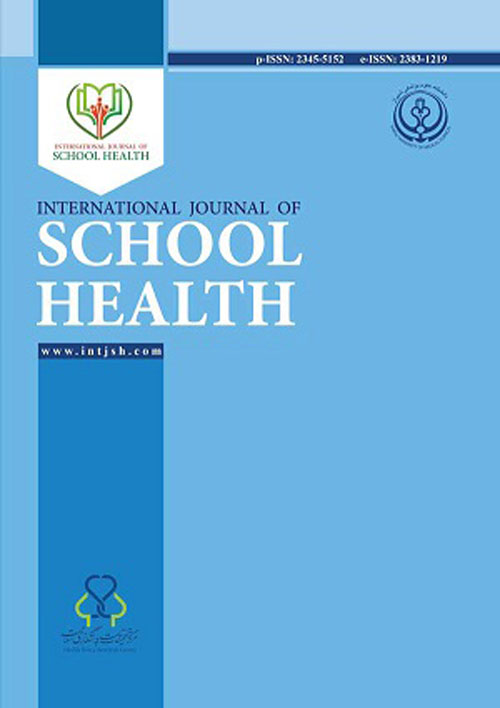فهرست مطالب

International Journal of School Health
Volume:5 Issue: 3, Summer 2018
- تاریخ انتشار: 1397/04/23
- تعداد عناوین: 6
-
-
Page 1BackgroundThe importance of school settings for obesity prevention efforts may be most critical in low-income rural areas where healthy eating and physical activity (PA) resources are scarce. This study examined the association of rural elementary school environmental characteristics with childrens PA behaviors at school.MethodsAnalyses were based on objectively measured height, weight, and PA data from 1443 first to sixth graders attending six rural elementary schools in Oregon. The School Physical Activity and Nutrition Environment Tool (SPAN-ET) was used to measure elementary school PA policy, practice, and physical environments. Multivariable linear regressions were used to examine associations of 29 SPAN-ET PA measurement criteria, with total PA (light, moderate, vigorous; min/d), and moderate-to-vigorous PA (MVPA; min/d), adjusting for child sex, age, and BMI z-score.ResultsOur final sample included 755 boys and 688 girls (9 ± 1.7 years); Of them, 16% were overweight and 21% obese. Total PA was positively associated with 21 SPAN-ET PA criteria (unadjusted P value ranged from 0.7 to 0.001; adjusted PConclusionsCharacteristics of rural school environments are associated with childrens PA behaviors at school. Structured physical education, classroom-based PA, PA messaging, and adequate indoor/outdoor space are important correlates of PA in rural schools.Keywords: Obesity Prevention, Physical Activity, School Environments
-
Page 2BackgroundThe importance of school settings for obesity prevention efforts may be most critical in low-income rural areas where healthy eating and physical activity (PA) resources are scarce. This study examined the association of rural elementary school environmental characteristics with childrens PA behaviors at school.MethodsAnalyses were based on objectively measured height, weight, and PA data from 1443 first to sixth graders attending six rural elementary schools in Oregon. The School Physical Activity and Nutrition Environment Tool (SPAN-ET) was used to measure elementary school PA policy, practice, and physical environments. Multivariable linear regressions were used to examine associations of 29 SPAN-ET PA measurement criteria, with total PA (light, moderate, vigorous; min/d), and moderate-to-vigorous PA (MVPA; min/d), adjusting for child sex, age, and BMI z-score.ResultsOur final sample included 755 boys and 688 girls (9 ± 1.7 years); Of them, 16% were overweight and 21% obese. Total PA was positively associated with 21 SPAN-ET PA criteria (unadjusted P value ranged from 0.7 to 0.001; adjusted PConclusionsCharacteristics of rural school environments are associated with childrens PA behaviors at school. Structured physical education, classroom-based PA, PA messaging, and adequate indoor/outdoor space are important correlates of PA in rural schools.Keywords: Obesity Prevention, Physical Activity, School Environments
-
Page 3BackgroundSchool principals have a crucial role on effectiveness of schools and their performance, especially in school health services programs. The purpose of this study was to predict principals performance in school health services based on Spiritual intelligence (SI) in high schools of Tabriz (Iran).MethodsThe population of this correlational research consisted of all high school principals of Tabriz (520) at the first to fifth educational districts in 2016. According to Krejcie and Morgans table, and first, stratified random sampling method was used by equally considering the districts of education, and in the second step, random sampling method was used in terms of schools; 225 principals, including 45 principals of each district were selected. Data collection was done by the Spiritual intelligence self-report inventory (SISRI-24, 2009) (α = 0.71) and a researcher-made questionnaire (α = 0.88).ResultsThe results of correlation test showed that there was a correlation amongst critical existential thinking (r = 0.59, PConclusionsStrengthening the spiritual intelligence of school principals could lead to improvement of managerial performance and continuous improvement of education.Keywords: Principal's Performance, Spiritual Intelligence, School Health Services, High School
-
Page 4BackgroundThe external focus of attention is one of the most important and effective variables of performance and motor learning.ObjectivesThe current study aimed at comparing the effects of external focus of attention with instructions, instructional self-talk, and augmented feedback strategies on motor learning in 10-year-old male students.MethodsSixty students (with the mean age of 10.10 ± 0.20 years) participated in the current study voluntarily as the study samples and were randomly divided into four groups of 15 students (three experimental groups and one control group). Participants practiced overarm throwing using their non-dominant arm. In the training phase, the subjects were trained for 300 throws in five sessions (60 attempts per session) and then, they performed a retention test. One-way analysis of variance (ANOVA) was used to determine the difference between the groups. In order to investigate the intervening effects in the four groups within the pre-test, post-test, retention stages, repeated measures ANOVA and in order to determine the differences between the groups, Bonferroni post-hoc test was applied.ResultsThe results showed that all groups except the control group progressed in post-test and retention tests. On both tests (post-test and retention), the augmented feedback group showed the greatest throwing accuracy (PConclusionsThe findings of the current study showed that the external focus of attention with the augmented feedback method was the best strategy to take advantage of the external focus of attention on motor learning in 10-year-old male students.Keywords: Feedback, Attention, Students
-
Page 5BackgroundIndoor environment, in which we are located, influences our psychological responses, like stress. Thermal comfort is one of the most important factors determining the quality of indoor environment, obtained by calculating predicted mean vote (PMV) and predicted percentage of dissatisfaction (PPD) in a steady-state approach. Several studies revealed that hot or cold temperature (°C) could increase stress. However, other climatic thermal comfort factors like relative humidity (%) and air velocity (m/s) have not been well researched in this regard.ObjectivesThe purpose of this study was to investigate the immediate effects of undesirable thermal comfort on stress by measuring salivary alpha-amylase levels (sAA) in female high school students.MethodsThe present study was conducted in a semi-experimental design with pre-test and post-test and control group. The sample size was 390 female high school students, who were selected by multi-stage cluster random sampling, during years 2016 and 2017, in Shiraz, Iran. Students were divided to intervention and control groups. In the intervention group, thermal comfort was interfered by changing temperature, relative humidity, and air velocity for two hours. Saliva was collected by Cocorometers strip and sAA was measured by a hand-held device, Cocorometer (Nipro Co, Osaka, Japan). The pre-test and post-test were compared with each other. Thermal comfort in classrooms was measured by a steady-state model, PMV/PPD index, and data was analyzed by Analysis of Covariance (ANCOVA).ResultsInterfering in temperatures and humidity at an average of 4.8°C and 36% for two hours in the intervention group caused thermal comfort to be in an unfavorable range (PMV > .5) and dissatisfaction was more than desirable (PPD > 10%). In the intervention group, when the intervention took place at the temperature, relative humidity, air velocity, and the synchronous effect of these three variables (TRHAV), the mean sAA was 43.57, 42.74, 44.23, and 45.93 (KU/L) in the pre-test and 55.91, 52.35, 44.89 and 61.99 (KU/L) in the post-test. Also, in the control group, the mean sAA was 44.73, 47.03, 43.38, and 44.36 (KU/L) in pre-test and 44.04, 47.19, 43.83, and 43.77 (KU/L) in the post-test. The sAA was significantly increased in the intervention group when thermal comfort and its climatic variables, including temperature (PConclusionsUndesirable thermal comfort increased stress in female high school students. Stress was affected by temperature, relative humidity and the synchronous effect of temperature, relative humidity, and air velocity yet not air velocity, individually.Keywords: Stress, Salivary Alpha, Amylases (sAA), Temperature, Humidity
-
Page 6BackgroundPrevious research has demonstrated that oppositional defiant disorder is a strong predictor of mental illness that causes significant distress for adolescents, who manifest this disorder and pose remarkable costs for the society.ObjectivesThe aim of this study was to design and test a model of some antecedents (secure attachment and insecure attachment, early trauma, behavioral activation system, behavioral inhibition system, schema, emotion regulation, and callous-unemotional) and consequences (aggression, conduct disorder, educational performance, and vandalism) of oppositional defiant disorder.MethodsThe sample consisted of 320 high school students of Dezfoul, who were selected by multistage random sampling. The instruments included the oppositional defiant behavioral inventory, revised adult scale (RAAS), Early Trauma Inventory, Carver and White Behavioral Activation System/Behavioral Inhibition system, Youngs Schema Questionnaire - Short Form, difficulties in emotion regulation scale (DERS), Callous-Unemotional trait inventory, Boss and Perry aggression questionnaire, child behavior checklist (CBCL), and questionnaire of vandalism. Structural equation modeling through AMOS 22 and SPSS 22 were used for data analysis.ResultsResults showed that the model with some modification had good fit with the data and model indicators (χ2/df = 3.24, GFI= 0.90, RMSEA= 0.07) improved. Six out of 20 direct paths were not significant, and were omitted from the model. Two out of nine indirect paths were omitted and the rest of the paths were confirmed.ConclusionsThe results showed that the model fitted the data with some amendments.Keywords: Oppositional Defiant Disorder, Attachment, Early Trauma, Brain, Behavioral System, Aggression, Conduct Disorder, Educational Performance, Vandalism


